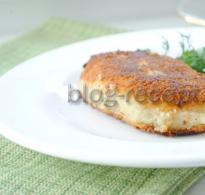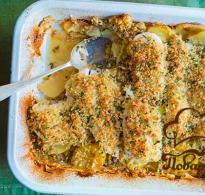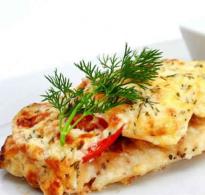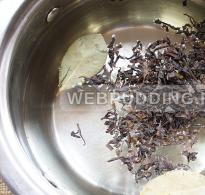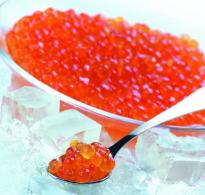Boiling cheese delicacy according to a Swiss recipe. National cuisine of Switzerland
Swiss cuisine has kindly borrowed the most successful culinary discoveries from all over Europe. At the same time, any Swiss dish has an interesting twist that makes it unique and so tasty.
Aristocrat's breakfast

Breakfast for any Swiss is sacred. Especially if it starts with ruddy ones, reminiscent of potato pancakes. Grate 800 g on a coarse grater raw potatoes, salt and pepper to taste, pour in 80 g of melted butter and mix. Spoon onto a hot frying pan with oil. thin flatbreads and fry for 4-5 minutes on each side. Golden rashti will be perfectly complemented by tender fish paste. Mix 200 g smoked salmon, 150 g cream cheese, 3-4 chives and beat everything in homogeneous mass. This exquisite combination ideal for family breakfast Sunday morning.
Cauldron of Pleasures

One of the peculiarities of Swiss cuisine is its love of cheese, which even the French would envy. The most striking cheese creation is fondue. Grate 200 g each of Gruyère and Emmental cheese. If they are not available, take domestically produced Gouda. Melt the cheese in a saucepan, add 200 ml of dry white wine, 30 ml of cherry vodka, 3 cloves of garlic, nutmeg, salt and pepper to taste. We withstand thick cheese mass over low heat for 5 minutes, stirring continuously with a whisk. Ideally, fondue is served in a caquelon, but a ceramic bowl or cast iron pot is also appropriate. You can dip anything into it: crispy bread cubes, fried shrimps or baked potato slices.
Tender soup

The national dishes of Switzerland are refined soups worthy of a social event menu. Melt 30 g of butter in a saucepan, add 1 tbsp. l. flour and lightly fry. Pour in 500 ml chicken broth and dissolve the flour in it. Add 100 ml of dry white wine, bring to a boil, simmer low heat 5–7 minutes. Melt 100 g of grated hard cheese in the broth, add a mixture of 2 egg yolks and 2 tbsp. l. sour cream, mix well with a whisk. At the end, season the soup with salt and pepper and nutmeg on the tip of a knife. Rub the baguette slices with garlic and brown them in a dry frying pan - this touch will make your soup flawless.
Golden calf

Meat dishes in Switzerland are also not complete without cheese. And white wine gives them refined notes. Cut 2 large potatoes into thin slices and soak in water for 30 minutes. Grind 700 g of veal into strips, fry until golden crust and put it on a plate. In the same oil, saute the onion with 300 g of champignons. Combine them with veal, season with 1 tbsp. l. flour, a pinch of thyme, salt and pepper. Simmer the mixture over low heat for 30–40 minutes, add 3 tbsp. l. sour cream and simmer for another 5 minutes. Fry dried potato slices in large quantities oils Duet tender veal and crispy potatoes - perfection. However, this dish can also be served with a more familiar side dish, such as rice.
Mystery covered in meat

Among the dishes there are interesting variations of poultry, such as chicken cordon bleu. Cut 8 wide slices of ham, place 2 tbsp on them. l. grated cheese and roll into tubes. Take 4 chicken breasts, use a sharp knife to cut pockets and place 2 ham tubes in them. Secure the breasts with a toothpick and put them in the freezer for 20 minutes. Then roll them in flour, dip them in a mixture of 3 eggs and 2 tbsp. l. mustard and roll thoroughly in breadcrumbs. Bake the breasts for 30 minutes at 200°C. Chicken in this guise will be loved by your family and friends from the first bite.
Sage perch

The national cuisine of Switzerland is rich and fish dishes. The Swiss have a special weakness for lake food. Cut 600 g of perch fillet into portions, sprinkle with salt and pepper and fry in vegetable oil until golden brown. Pour 300 ml of white wine over the fish and simmer over low heat for 5–7 minutes. Place the perch on a plate, and add 100 g of butter, a bunch of chopped chives and ½ a bunch of parsley to the frying pan with the wine. Smoothly bring the sauce to a boil, add 2 egg yolks from 1 tbsp. l. mustard and, stirring often, simmer for a couple more minutes. Perch with such a noble sauce will be a delicious discovery for the whole family.
Pedigree Pie

Do you want to pamper your sweet tooth with a real Swiss dessert? Bake pecan pie, the recipe for which was invented back in 1900. Knead the dough from 300 g flour, 160 g butter, 130 g sugar, 1 tbsp. l. cream, eggs and a pinch of salt. Divide it into two lumps and cool for 40 minutes. Brown 250 g of sugar in a dry saucepan. Pour in 200 ml of warm cream, simmer for 5 minutes, add 60 g of crushed almonds and 1 tbsp. l. honey Place some of the dough into an oiled pan, forming sides. Fill it out nut filling and cover with the second part of the dough. Place the pie in the oven for 45 minutes at 180°C. Such delicious dessert will add a bit of charm to a friendly tea party.
These recipes may well add to your culinary collection. Perhaps you have already tried something from Swiss cuisine? Then be sure to tell us about your memorable dishes.
The traditions of Swiss cuisine are based on the traditions of the cuisine of Germany, France and Italy. Exactly culinary preferences These three countries influenced the gastronomic tastes of the inhabitants of Switzerland, the most neutral European country.
So many national Swiss dishes are borrowed from other cuisines, although they are considered originally Swiss. Although, in fact, only fondue can be classified as such. And then the French dispute the right to this dish.
Swiss cheeses
If you ask a resident of any country to name three associations that Switzerland evokes in him, one of these words will definitely be “cheese”. Cheese is used in many recipes in Swiss cuisine - in soups, salads, side dishes and desserts. One of the most beloved dishes in this country, raclette, is also made from cheese. Translated from French name means " coarse grater" To prepare raclette, grate the cheese on a coarse grater and heat over low heat until it becomes liquid. Served with potatoes.
The taste of cheese depends on the quality of the milk. And in Switzerland they strictly monitor him - they take various samples, conduct all kinds of experiments. Cheese is prepared manually and automatically. The manual method makes the product tastier and “warmer”, and its price is correspondingly higher.
Fondue
This is melted cheese, to which garlic and light white wine are added. Alpine shepherds were the first to prepare this dish - they threw the remaining cheese into the cauldron and dipped it in aromatic mixture pieces of white bread. The end result was satisfying and original dish. Now fondue has become a national symbol of Switzerland. It is prepared from different varieties cheese, but five are traditionally used, including hard Emmental, Roquefort and provolone.
Now there is vegetable, meat, fish and even chocolate fondue- for those with a sweet tooth. It is prepared quite simply: melt chocolate, add liqueur and cognac. Pieces of fruit are strung on a fork and dipped into the chocolate mixture.
In meat, fish and vegetable fondues, instead of cheese mass, vegetable oil, where pieces of meat or vegetables are dipped.
Swiss chocolate
Everyone knows the Swiss love of chocolate. In Switzerland, chocolate is more than just an ordinary treat. This is the basis of the country's financial well-being. The history of chocolate goes back at least three thousand years. The Olmecs, who inhabited the south of modern Mexico, were the first to obtain a bitter drink from cocoa beans. His recipe was extremely simple: in water with cornmeal The seeds of the cacahuatl tree were boiled. The thick, foamy mass was called “chocolatl,” and scientists have two versions of the translation of this word. The first of them is “bitter water”, the second is “whipped drink”. The first European to try “chocolatl” was Christopher Columbus. The conqueror of Mexico, Hernan Cortez, is credited with playing a key role in popularizing chocolate among Europeans. In 1519, the Aztec ruler Moctezuma gave him an entire plantation of cocoa trees, and in 1528, Spanish galleons brought chocolate to Europe. It was in Spain in 1580 that the first in the Old World appeared chocolate Factory. By the 17th century, chocolate had become a fashionable but expensive pleasure at the Spanish court, and at the beginning of the century the supply of chocolate began in many European countries. Chocolate arrived in Switzerland at the end of the 17th century, and at first it was given out by prescription as a medicine. Only in 1819, a native of the country, Francois-Louis Cahier, fundamentally developed the new kind chocolate - hard. And exactly a year later, on the site of a former mill near the town of Vivi, the world's first factory for the production of chocolate bars was built. In 1825, Philippe Suchard began selling his chocolate in Neuchâtel, laying the foundation for the future Suchard brand, and in 1867, Johann Jacob Tobler opened his confectionery in Bern. In 1905, his son Theodore began producing Tobleron chocolate, which is well known to this day.
Now Switzerland holds the record for chocolate consumption per capita, because the average Swiss eats more than twelve kg annually. chocolate per year.
The national cuisine of Switzerland incorporates the best culinary traditions Italian, French and German cuisine. After all, these countries are our closest neighbors. Main components local cuisine these are cheese, milk, meat, eggs, butter, flour and spices. It is worth noting that all these products highest quality, natural, fresh and without harmful additives. There is even a special organization in the country that issues certificates for the best Swiss products, which are awarded the prestigious quality mark - IGP or AOC. These truly folk products include: dried meat from Graubünden, cheese “raclette”, Welsh Rye bread, fried Bratwurst pork sausages, Vaud sausages and many others.

Home business card, cuisines of Switzerland , cheese and dairy products are considered. There are more than 150 types of cheese in this small country. The most famous - " Emmental, Gruyère, Appenzellern, Piora, Vacherin, Schabziger« and others. And the most famous Swiss dish- “fondue”. Several types of cheese are melted in boiling white wine and various spices are added. This dish is served hot with small pieces of white bread, which are dipped in the mixture and washed down with white wine. This classic version fondue. Sometimes they cook it right on the table, in one pot for the whole company.

In recent years, Swiss "fondue" has acquired a wider meaning. There are many types of this dish, which are prepared using completely different technologies and recipes. For example:
- “chicken fondue” - chicken fillet stewed in creamy sauce;
- « rustic fondue» - fried meat with potatoes, covered in melted cheese;
- « Burgundy fondue» - boiled meat with cheese and spices;
- « chocolate fondue“—molten chocolate with honey and almonds, into which fruits, waffles, cookies, and bread are dipped.
And even such unusual options- “blueberry fondue” and “ ice cream fondue".

There are also others cheese dishes, enjoying well-deserved popularity. Be sure to try:
- “raclette” - boiled potatoes (sometimes in their jackets) with melted cheese and crispy pickled cucumbers;
- « Swiss cheese hot soup» with fried crackers;
- "Swiss style meat", generously sprinkled with grated cheese; scrambled eggs in a water bath with cheese;
- "rösti" - fried flatbread from boiled potatoes(reminiscent of our pancakes), sprinkled with cheese.

As a first course, Swiss cuisine will offer you:
- vegetable minestrone soup,
- « barley soup from Grisons",
- Ticinese soup "busecco" with giblets,
- "Flour Stew from Basel".
For the second one you should try:
- "geschnetzeltes" - narrow strips roast veal with mushrooms, herbs and sauce;
- "Bernes platter" - fried pork with beans or sauerkraut;
- "Bundenfleisch" - beef jerky with salted onions;
- "knackerly" - spicy sausages with sauce and spices;
- "leberwurst" - smoked sausage from liver and lard;
- "krepfli" - puff pastries with various fillings.

Swiss cuisine did not ignore the sweet tooth. First of all, this is the famous Swiss chocolate. Each Swiss eats more than 12 kilograms of chocolate per year. Also, try:
- "lekerli" - honey gingerbread; gingerbread from Basel;
- “kyukhli” - sweet pies;
- "Brunsley" - chocolate cookies with almonds;
- "Zuger-Kirshtorte" - layered cake with sweet filling;
- “muesli” with nuts, apples and raisins (by the way, this dish was invented in Switzerland).

From soft drinks The Swiss prefer coffee, milk, fruit juices, hot chocolate. Samichlaus beer is popular, with a strength of up to 14%. Swiss wines are also excellent - “ Ferdan", "Lavyu", "Coron", "Dol", "Johanniober", "Lamey" and others. From more strong drinks- “Kirsch” (cherry vodka), “Pflumli” (plum brandy), “Williams” (pear brandy).
Welcome to hospitable Switzerland and bon appetit everyone!

To make cheese fondue at home? What secrets do you need to know to choose the best set?
Let's say right away: even the classic version of the dish is a real work of art that has own characteristics preparations. We will tell you about them. (Portal "Switzerland Business")
The most delicate Swiss cheese, lazily melted over low heat... Such a pleasure will not leave even the most fastidious gourmet indifferent!
It is not surprising that Swiss fondue has earned itself a worldwide reputation: today the national dish of Switzerland is preferred to be enjoyed in all corners of the world. The reviews are always positive!
However, preparing it is not an easy task. It is not enough to simply melt a piece of cheese over low heat and dip the bread crust into it.
As you have already noticed, we started the story with just one type - cheese fondue. Besides this there are also others:
- chocolate fondue and
- fondue chinoise.
You can talk about each of them non-stop for hours. However, in order to keep the topic of the article clear, within the framework of this material we will only touch on the history and cheese fondue recipes.
History of origin
Name " fondue" comes from the French word " fondue", which translates as "melted" or "melted". The history of its origin dates back 7 centuries ago in.
There are at least 2 theories about the origin of the Swiss national dish.
An invention of Swiss shepherds?
Going to work in the snowy regions, Swiss shepherds took with them the most nourishing and common foodstuffs - bread and cheese. There was also always wine to warm up from the cold (well, you understand! 🙂).
One day, in an attempt to somehow add flavor to the hardened cheese, they decided to melt it in a pan over a fire with the addition of wine. The crusts of bread were dipped into the resulting mass.
 In the past, it was (culinary) ingenuity that helped Swiss shepherds endure the rigors of winter in the Alps. In the photo: a mountain hut in the canton. Graphic: swiss-image.ch/Christof Sonderegger
In the past, it was (culinary) ingenuity that helped Swiss shepherds endure the rigors of winter in the Alps. In the photo: a mountain hut in the canton. Graphic: swiss-image.ch/Christof Sonderegger Today this theory is considered the most likely origin story Swiss fondue and is very common in mountainous regions.
Or the monk's cunning?
There is also another legend of the origin of the Swiss cheese delicacy. In the 13th century, a monk named Vacarinus decided to circumvent the ban on eating hard cheese during fasting. He heated the product to liquid consistency and introduced it as " cheese soup».
The other monks argued for a long time about how different such a dish was from the forbidden cheese, but as a result they allowed it to be consumed during Lent.
- Homer's Iliad describes a dish that closely resembles Swiss fondue. In particular, grated goat cheese, wine and flour had to be boiled for open fire. Although the recipe is more than 2800 years old, the dish can easily be called an old relative of the Swiss national dish.
- Until now, Italy also disputes the fact that cheese fondue was “born” in Switzerland. However, it has been proven that its homeland is Swiss.
- The first full written mention of Swiss fondue dates back to 1699. IN cookbook Anna Margaretha Gessner referred to the dish as “cheese and wine” (German: “Käss mit Wein”).
- French philosopher Jean-Jacques Rousseau was also a fan of it. In his letter to his friend François Coindet, he writes that if his friend found a piece of Gruyère cheese, they could enjoy the Swiss cheese delicacy.
- With the onset of the Great Depression in 1914, the Swiss Cheese Association faced a serious decline in product sales. To somehow stay afloat, she started selling cheese for making fondue. As a result, the dish appears at the national exhibition "Village Suisse" in, and then at the World's Fair in New York in 1939 - 1940.
- By the 1950s, the dish gained unprecedented popularity throughout Switzerland, which was facilitated by the Swiss Cheese Association. In 1954, a massive free fondue tasting took place in Schaffhausen.
- In November 2018, it announced fondue also in economy class on some routes. Previously the privilege to feast on cheese product at an altitude of 11 thousand meters above the surface of the Earth, only business class passengers had access.
Cheese fondue recipes
Ingredients
To prepare a classic cheese fondue at home, you will need a few ingredients.
 Photo: the_junеs, CC BY 2.0
Photo: the_junеs, CC BY 2.0 Cheese
First of all, you should choose the basis of our dish -. Often in Switzerland, Gruyère or cheese is used, but Vacherin Fribourgeois, Raclette, Appenzeller, Tilsilter and Sbrinz cheeses are also very popular.
In general, one person will need about 200-250 grams of cheese. Accordingly, for a company of 4 people – about 800-1000 grams.
Wine
The second important ingredient is. Dry white wine is perfect, to which you will need to add one tablespoon of lemon juice during cooking (it will prevent the cheese from thickening). You can also use sparkling wine And apple cider(see below for information on their use).
 Photo: swiss-image.ch / Hans-Peter Siffert
Photo: swiss-image.ch / Hans-Peter Siffert Do not overdo it with wine - due to the consistency of the cheese mass, too much wine can cause a state of (mild) intoxication. There should be just enough wine so that only alcoholic vapor is felt. The optimal volume is 3.5 deciliters.
If you plan for children to eat cheese fondue, you should make it no wine. The latter should be replaced with non-alcoholic apple wine.
Spices
No Swiss fondue is complete without aromatic spices. Nutmeg, garlic and pepper are often added to the dish. Depending on your taste preferences, you can use onions, cumin, paprika, Green pepper and even curry!
In the case of garlic, 1-2 cloves will be enough. 3-4 teaspoons of seasonings are enough.
Bread
Both white and black bread are suitable for cooking. Rye bread, wholemeal bread and baguette are also allowed. But purely for aesthetic reasons, we advise you to use White bread, to ready dish kept the same color scheme.
Small advice: It is best to use slightly stale bread. This way the cheese will soak up the piece much better. In addition, a slice will allow you to feel the atmosphere in the Swiss Alps, when local shepherds really only had stale bread at their disposal.
In total, about 600 grams of bread is enough for 4 people.
Dishes -
Preparing Swiss fondue is simply impossible without using special utensils, which are popularly called simply “”. Basic set utensils look like this: a special saucepan " caquelon» stands on a stand above a candle or burner. The set is complemented by special forks.
 Photo: André Karwath, CC BY-SA 2.5
Photo: André Karwath, CC BY-SA 2.5 For some time now you can buy an electric kit. However, traditional cookware uses fire from a burner.
Having arrived in the Confederation, many are sure to try to buy a fondue pot. However, we will give you advice: Do not buy fondue makers in souvenir shops in Switzerland - there you will still only find low-quality items imported from China. If you need a really high-quality saucepan, then buy it where they make it themselves - in local stores (for example, Migros or Coop). Pay attention to the label “ Made in Switzerland“. A Swiss-made fondue maker may be expensive, but its quality is worth the cost.
You are unlikely to be able to prepare a cheese delicacy without a fondue pot (for example, in a slow cooker): the cookware is made specifically for this dish and has the appropriate properties.
How to prepare fondue: step-by-step instructions
The recipe is very simple. Cooking time at home: only about 15 minutes! There are plenty of cooking tips on the internet. We present to your attention a classic Swiss recipe:
- For convenience, pre-cut the bread into pieces approximately 2 x 2 cm.
- Light the fuel in the burner.
- Rub the sides of the fondue pot with garlic.
- Then pour the pre-grated cheese into the container. Pour in the wine and lemon juice. Add spices to taste.
- Cook the mixture over medium heat, strongly stirring and not bringing to a boil.
- “Simmer” the dish for about 5 minutes until the cheese is completely melted.
- The finished product should be served immediately. Remember: when dipping a fork with bread into the cheese mixture seasoned with wine, do not forget to stir it (the fork) periodically. Optimal time You will determine the dips for yourself instinctively after the first run.
 Bon appetit! Photo: Proximo86, GFDL
Bon appetit! Photo: Proximo86, GFDL The hot cheese delicacy is especially loved by the Swiss during the cold season (it is often made, for example, on).
Varieties of fondue in Switzerland and beyond
Cantonal differences
Depending on the fondue recipe may differ (even very much). Often, each region prefers a certain type of cheese.
For example, in the canton Gruyère and Vacherin Fribourgeois are most often used, while Gruyère and Raclette are more common. Some Swiss people really like to combine several types of cheese in different proportions.
Variations with alcohol are also acceptable. For example, white wine can be replaced with champagne or apple cider. Quite often bread is replaced with potatoes or other vegetables. For example, in the canton they use salted dried meat, known locally as “Bündnerfleisch” ( Bündnerfleisch). And in the canton cheese fondue eaten with fresh vegetables.
In the world
As already stated, National dish The Swiss have enjoyed it in many other parts of the world. It is even prepared for weddings.
With the fact that the fame of cheese delicacy spread throughout the world, another phenomenon arose: each country began to develop its own cooking characteristics. So, in Russia they sometimes eat fondue with sausages. In Switzerland itself, sausages are never served with fondue. The same applies to eggplants, shrimp, etc.


